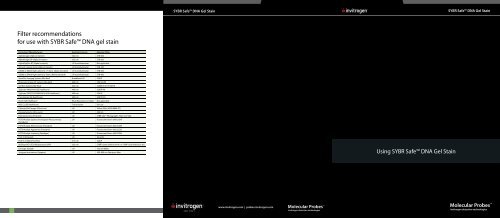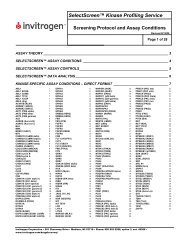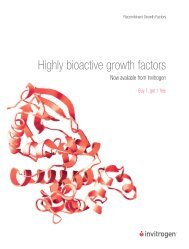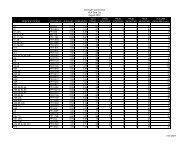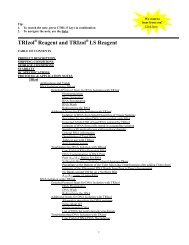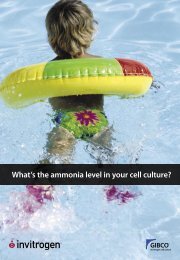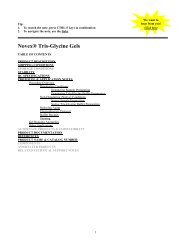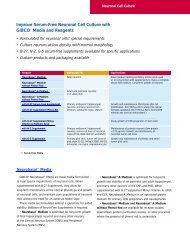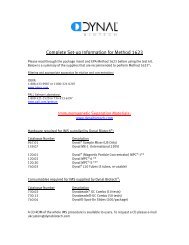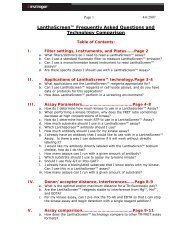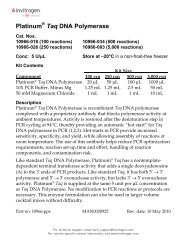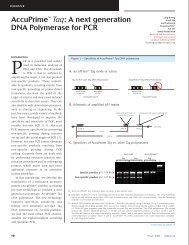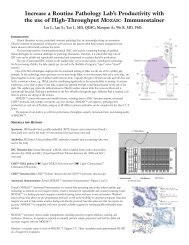Using SYBR Safe™ DNA Gel Stain - Invitrogen
Using SYBR Safe™ DNA Gel Stain - Invitrogen
Using SYBR Safe™ DNA Gel Stain - Invitrogen
You also want an ePaper? Increase the reach of your titles
YUMPU automatically turns print PDFs into web optimized ePapers that Google loves.
Filter recommendations<br />
for use with <strong>SYBR</strong> Safe <strong>DNA</strong> gel stain<br />
Instrument (Manufacturer) Excitation Source Emission Filter<br />
AlphaImager (Alpha Innotech) 302 nm SYB-500<br />
AlphaImager HP (Alpha Innotech) 302 nm SYB-500<br />
AlphaDigiDoc RT (Alpha Innotech) UV transilluminator Not applicable<br />
Shroud, Camera Stand (Alpha Innotech) UV transilluminator SYB-100<br />
DE500 or DE400 light cabinet 2.17” diam. (Alpha Innotech) UV transilluminator SYB-500<br />
DE500 or DE400 light cabinet 2” diam. (Alpha Innotech) UV transilluminator SYB-400<br />
VersaDoc Imaging Systems (Bio-Rad) Broadband UV 520LP<br />
Molecular Imager FX Systems (Bio-Rad) 488 nm 530 nm BP<br />
<strong>Gel</strong> Doc Systems (Bio-Rad) 302 nm 520DF30 (#170-8074)<br />
Typhoon 9400/9410 (GE Healthcare) 488 nm 520 BP 40<br />
Typhoon 9200/9210/8600/8610 (GE Healthcare) 488 nm 526 SP<br />
FluorImager (GE Healthcare) 488 nm 530 DF 30<br />
Storm (GE Healthcare) Blue (fl uorescence mode) Not applicable<br />
VDS-CL (GE Healthcare) Transmission UV Low<br />
Ultracam/<strong>Gel</strong> Imager (Ultra-Lum) UV Yellow Filter (#990-0804-07)<br />
Omega Systems (Ultra-Lum) UV 520 nm<br />
Polaroid Camera (Polaroid) UV <strong>SYBR</strong> Safe Photographic Filter (S37100)<br />
FOTO/Analyst Express/Investigator/Plus/Luminary<br />
(Fotodyne)<br />
UV Fluorescent Green (#60-2034)<br />
FOTO/Analyst Minivisionary (Fotodyne) UV Fluorescent Green (#62-4289)<br />
FOTO/Analyst Apprentice (Fotodyne) UV Fluorescent Green (#62-2535)<br />
FOTO/Analyst Luminary (Fotodyne) UV Fluorescent Green (#60-2056)<br />
FCR-10 (Polaroid) UV #3-4218<br />
FUJI FLA-3000 (FUJI Film) 473 nm 520LP<br />
BioDocIt/AC1/EC3/BioSpectrum (UVP) 302 nm <strong>SYBR</strong>® Green (#38-0219-01) or <strong>SYBR</strong>® Gold (#38-0221-01)<br />
<strong>Gel</strong> Logic (Kodak) UV 535 nm WB50<br />
Syngene Instruments (Syngene) UV 500–600 nm Shortpass fi lter<br />
<strong>SYBR</strong> Safe <strong>DNA</strong> <strong>Gel</strong> <strong>Stain</strong><br />
62923 TC562-1<br />
www.invitrogen.com | probes.invitrogen.com<br />
<strong>Using</strong> <strong>SYBR</strong> Safe <strong>DNA</strong> <strong>Gel</strong> <strong>Stain</strong><br />
<strong>SYBR</strong> Safe <strong>DNA</strong> <strong>Gel</strong> <strong>Stain</strong>
���������������� ��<br />
���������������������������������<br />
<strong>Using</strong> <strong>SYBR</strong> Safe <strong>DNA</strong> <strong>Gel</strong> <strong>Stain</strong><br />
You have questions, we have answers.<br />
<strong>SYBR</strong> Safe <strong>DNA</strong> gel stain was designed to replace ethidium bromide—a known mutagen—while offering uncompromised<br />
staining performance. <strong>SYBR</strong> Safe <strong>DNA</strong> gel stain is less mutagenic, less toxic, more environmentally friendly, and it works with<br />
traditional gel staining methods.<br />
The practical information contained in this brochure represents many hours of bench experience with <strong>SYBR</strong> Safe stain.<br />
We hope these guidelines will help you easily and effectively bring <strong>SYBR</strong> Safe stain into your lab. If you’re ready to put the<br />
potential health risks of ethidium bromide in your past, <strong>SYBR</strong> Safe <strong>DNA</strong> gel stain is the answer.<br />
Safety<br />
Q How should I dispose of <strong>SYBR</strong> Safe stain?<br />
A Some institutions and municipalities have approved the<br />
disposal of <strong>SYBR</strong> Safe stain directly into their waste<br />
water systems. However, disposal regulations vary—<br />
please contact your safety office or local municipality for<br />
disposal guidelines.<br />
Q Is <strong>SYBR</strong> Safe stain really safe? Do I have to use gloves<br />
when I use it?<br />
A In numerous tests carried out by independent, licensed<br />
testing laboratories, <strong>SYBR</strong> Safe stain showed little<br />
or no genotoxicity and no acute toxicity. This stain is<br />
not classified as hazardous waste under U.S. federal<br />
regulations; nevertheless, please exercise common safe<br />
laboratory practice when using this reagent.<br />
Q Where can I find more safety information about<br />
<strong>SYBR</strong> Safe stain?<br />
A Our website (probes.invitrogen.com/sybrsafe) contains<br />
all of our latest testing results.<br />
Q I work in an institution/city/state/country that requires<br />
additional tests to allow me to dispose of this down the<br />
drain. Will <strong>Invitrogen</strong> perform these tests?<br />
A Safety and environmental testing of <strong>SYBR</strong> Safe stain is<br />
ongoing. Please contact us at sybrsafe@invitrogen.com.<br />
We will work with you to obtain disposal approval.<br />
Imaging<br />
Q Can bands be seen on a UV transilluminator without<br />
the use of emission filters?<br />
A Bands stained with <strong>SYBR</strong> Safe stain are visible to the<br />
eye on a 300 nm transilluminator. However, maximal<br />
detection is obtained by photographing the gel by<br />
using a UV-compatible emission filter with your CCD<br />
or film camera. UV bulbs may also emit some IR; if<br />
your camera lens is not specially coated to block IR, an<br />
IR-blocking filter is needed to prevent the appearance of<br />
faint images of the UV bulbs behind your gel.<br />
Q How do I use the <strong>SYBR</strong> Safe photographic filter?<br />
A The <strong>SYBR</strong> Safe photographic filter mounts directly in<br />
front of the lens of any standard Polaroid system, for those<br />
using Polaroid B&W film (#667) to document their gels.<br />
Q What is the recommended filter for my gel documentation<br />
system?<br />
A The table appearing later in this brochure lists recommended<br />
filters for specific gel documentation systems.<br />
If your system is not listed, contact the manufacturer for<br />
recommendations. Note that the excitation and emission<br />
spectra of <strong>SYBR</strong> Safe stain are very similar to those of<br />
<strong>SYBR</strong>® Green I, <strong>SYBR</strong>® Green II, and <strong>SYBR</strong>® Gold dyes, as<br />
well as fluorescein (FITC). Therefore, filters appropriate for<br />
these dyes can also be used.<br />
Q What are the recommended photographic settings for<br />
my gel documentation system?<br />
A Since there are so many different camera systems and<br />
emission filters, it is difficult to recommend specific<br />
photographic settings. Ideal exposure settings can be<br />
determined empirically; the manufacturer of the gel<br />
documentation system may be able to provide more<br />
detailed guidance.<br />
Q Can I use <strong>SYBR</strong> Safe stain with my ethidium bromide<br />
filter and camera settings?<br />
A Some ethidium bromide filters allow the transmission<br />
of all light above 500 nm. These filters (which often<br />
appear yellow) and their associated camera settings<br />
can be used with <strong>SYBR</strong> Safe stain, usually with only<br />
minor adjustments to the exposure or gain. Other<br />
ethidium bromide filters (often red in appearance) only<br />
transmit light around or above 600 nm; these filters<br />
and their associated camera settings are not suitable<br />
for use with <strong>SYBR</strong> Safe stain.<br />
Q What other excitation wavelengths can I use to visualize<br />
<strong>SYBR</strong> Safe stain?<br />
A <strong>SYBR</strong> Safe stain has two main excitation peaks: in the<br />
UV at 280 nm, and in the visible region at 502 nm. Thus,<br />
254 nm or 300 nm UV-excitation will work, as will 488 nm<br />
lasers, 470 nm LEDs, and broad blue excitation (such as<br />
<strong>Invitrogen</strong>’s Safe Imager (coming September 2005) and<br />
Clare Chemical’s Dark Reader). The full excitation and<br />
emission spectra for <strong>SYBR</strong> Safe stain are provided on<br />
our website (probes.invitrogen.com/sybrsafe) and in<br />
the protocol provided with the stain.<br />
Q Why do I sometimes see “speckles” in my gel when<br />
using <strong>SYBR</strong> Safe stain?<br />
A Many whitening agents used in clothing, as well as some<br />
fungi and bacteria, fluoresce at the same wavelength as<br />
<strong>SYBR</strong> Safe stain. These contaminants within or on the<br />
surface of the gel may produce this “speckling.”<br />
Q How can I get a <strong>SYBR</strong> Safe T-shirt?<br />
A Send us an image of <strong>SYBR</strong> Safe stain obtained on your<br />
imaging system. If your image is the first received for<br />
that imaging system, we will send you a <strong>SYBR</strong> Safe<br />
T-shirt. Send images to sybrsafe@invitrogen.com;<br />
remember to include the complete photographic<br />
details of your image and imaging system.<br />
Application<br />
Q Is <strong>SYBR</strong> Safe stain compatible with the same<br />
applications as ethidium bromide?<br />
A <strong>SYBR</strong> Safe stain is compatible with all downstream<br />
applications we have tested so far, including excising<br />
PCR products from gels, gel purification, Gateway®<br />
cloning, and restriction enzyme cloning. If you have a<br />
unique application that works with <strong>SYBR</strong> Safe stain,<br />
send us the details at <strong>SYBR</strong>Safe@invitrogen.com and<br />
receive a <strong>SYBR</strong> Safe T-shirt.<br />
Q How much of the 10,000X concentrate should I use?<br />
A Dilute <strong>SYBR</strong> Safe stain concentrate 10,000-fold in<br />
TAE or TBE buffer prior to use. 50 mL of 1X stain is<br />
sufficient for most minigels (e.g., dilute 5 µL of con-<br />
centrate with 50 mL buffer). For larger gels, increase<br />
volumes proportionally, ensuring that the entire gel<br />
is fully immersed during staining.<br />
Q What is the lower limit of detection of <strong>SYBR</strong> Safe stain?<br />
A <strong>SYBR</strong> Safe stain yields the same sensitivity as ethidium<br />
bromide—roughly 500 pg/band in a minigel for<br />
fragments larger than 200 bp viewed on a 300 nm<br />
transilluminator.<br />
Q Can I reuse <strong>SYBR</strong> Safe stain for a second gel?<br />
A We strongly discourage the reuse of <strong>SYBR</strong> Safe stain,<br />
as this practice significantly lowers sensitivity.<br />
Q Is <strong>SYBR</strong> Safe stain microwaveable?<br />
A <strong>SYBR</strong> Safe stain may be briefly microwaved with no<br />
loss of performance. However, we do not know the<br />
effect of repeated or very long duration microwaving.<br />
<strong>SYBR</strong> Safe <strong>DNA</strong> <strong>Gel</strong> <strong>Stain</strong><br />
Q Does <strong>SYBR</strong> Safe stain need to be used in a dark room?<br />
A We recommend that <strong>SYBR</strong> Safe stain be protected<br />
from light during storage and gel staining. However,<br />
it is sufficiently stable to withstand UV illumination<br />
for >30 minutes; realistically, hours of constant UV or<br />
bright room light exposure are required to cause any<br />
significant loss of signal.<br />
Q Does <strong>SYBR</strong> Safe stain affect cloning efficiencies?<br />
A We have found a distinct advantage to using<br />
<strong>SYBR</strong> Safe stain rather than ethidium bromide<br />
when purifying <strong>DNA</strong> from gels for downstream use.<br />
<strong>SYBR</strong> Safe stain is compatible with non-UV blue light<br />
imaging systems—you can therefore purify <strong>DNA</strong> with<br />
virtually no UV-induced nicking or crosslinking and<br />
achieve dramatically increased cloning efficiency.<br />
Q Is <strong>SYBR</strong> Safe stain available in any precast gels?<br />
A E-<strong>Gel</strong>® 1.2% and E-<strong>Gel</strong>® 2% products are now available<br />
with <strong>SYBR</strong> Safe stain. These gels can be used in the<br />
same manner as their ethidium bromide counterparts.<br />
For more information on E-<strong>Gel</strong>s® with <strong>SYBR</strong> Safe, visit<br />
www.invitrogen.com/egels.<br />
Q Does ethanol precipitation remove the dye?<br />
A <strong>SYBR</strong> Safe stain is easily removed from nucleic acids<br />
by ethanol precipitation.<br />
Q Which direction does the dye run during electrophoresis?<br />
A Similar to ethidium bromide, <strong>SYBR</strong> Safe stain runs<br />
in the direction opposite migrating <strong>DNA</strong>. This has no<br />
practical effect on the use of precast gels containing<br />
<strong>SYBR</strong> Safe stain, as only the very bottom edge of the<br />
gel will have a lower concentration of stain. This effect<br />
can be partially counteracted by adding <strong>SYBR</strong> Safe<br />
stain to the running buffer.<br />
w w w.invitrogen.com | probes.invitrogen.com


